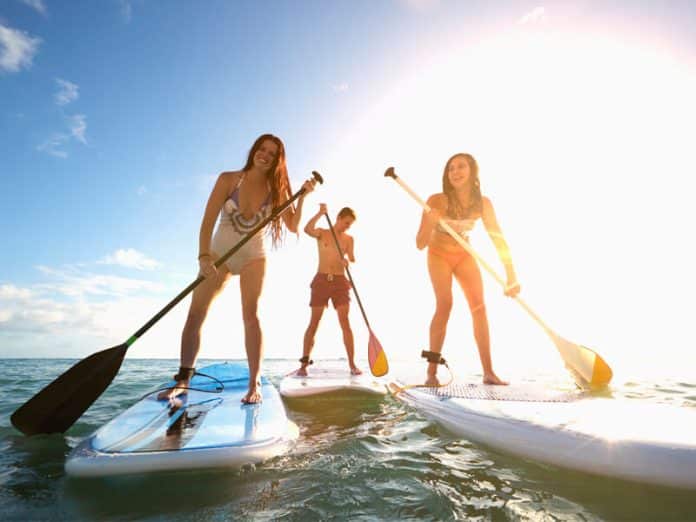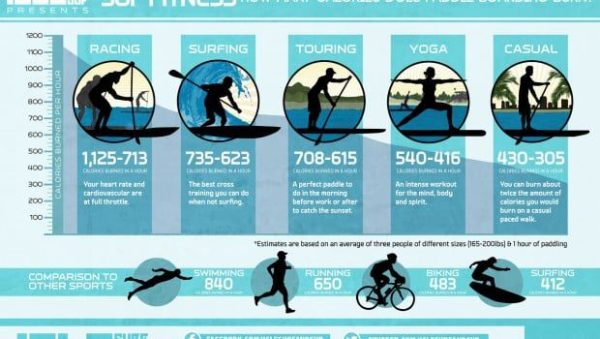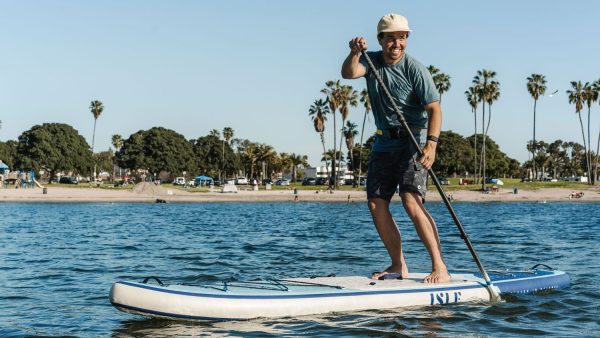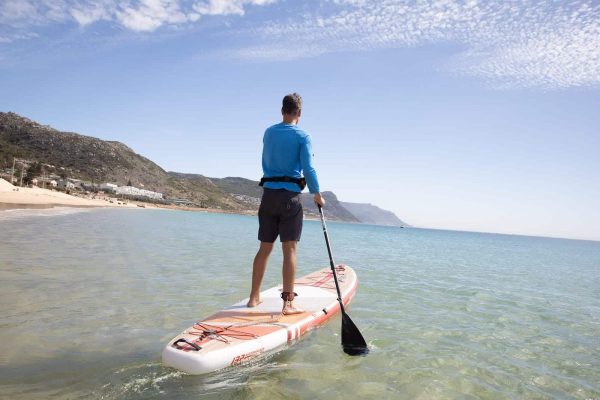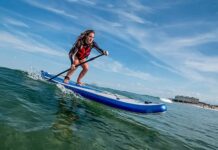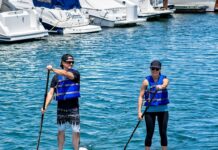Join us as we explore the exciting world of SUP fitness and discover how it sets itself apart from regular paddleboarding. With a unique blend of strength, balance, and cardiovascular exercises, SUP fitness takes your paddleboarding experience to a whole new level. Whether you’re a seasoned paddler or a first-timer, we invite you to dive into this invigorating activity that promises not only a full-body workout but also an opportunity to connect with nature in a refreshing way. So grab your paddleboard and let’s embark on a fitness journey like no other!
Physical Demands
Muscle Groups Used
When it comes to SUP fitness, the physical demands on our bodies are quite different from regular paddleboarding. While paddleboarding alone mainly targets the muscles in our arms, shoulders, and back, SUP fitness engages a wider range of muscle groups. As we navigate through different workout routines on the board, we find ourselves using our legs, glutes, and core muscles more intensively. This full-body workout makes SUP fitness an excellent option for those looking to maximize their muscle engagement during water-based activities.
Cardiovascular Intensity
In terms of cardiovascular intensity, SUP fitness takes regular paddleboarding to a whole new level. While paddleboarding can be a leisurely activity that allows us to enjoy the serenity of the water, SUP fitness ramps up the intensity to provide a great aerobic workout. By incorporating interval training and high-intensity movements, SUP fitness gets our heart rate up, improving our overall cardiovascular health. This increased intensity not only helps to build our endurance but also burns more calories, making it an excellent choice for those seeking to improve their cardiovascular fitness.
Equipment
Paddle Length and Design
When engaging in SUP fitness, it’s essential to choose the right paddle length and design to optimize our workout. Unlike regular paddleboarding, where we can opt for longer paddles for stability and leisurely strokes, SUP fitness requires a paddle that allows for quick and efficient movements. A shorter and lighter paddle is ideal for our workout routines, as it enables us to maneuver with ease and perform the various exercises effectively. Additionally, selecting a paddle with a smaller blade surface area can reduce strain on our muscles, allowing us to paddle longer and harder without excessive fatigue.
Board Size and Stability
Board size and stability also play a crucial role in SUP fitness. While regular paddleboards tend to be wider and provide better stability for leisurely rides, SUP fitness boards are narrower and offer lesser stability. This narrower design challenges our balance and engages our core muscles as we work to maintain stability during exercises. Choosing a board with a pointed nose and a narrower width provides a more dynamic workout experience, enhancing our ability to engage different muscle groups and intensify our workout routines.
This image is property of www.supworldmag.com.
Movement Patterns and Techniques
Balance and Core Engagement
One of the significant differences between SUP fitness and regular paddleboarding is the focus on balance and core engagement. Regular paddleboarding may require some balance, but SUP fitness takes it to the next level. During SUP fitness, we need to maintain a stable and balanced position on the board while performing various exercises. This constant engagement of our core muscles not only strengthens and tones our midsection but also improves our overall stability and proprioception. By challenging our balance and core, SUP fitness offers a unique and effective way to strengthen the muscles that support our spine and improve our overall body control.
Stroke Efficiency and Technique
While paddleboarding typically involves a relaxed and leisurely stroke technique, SUP fitness relies on efficient and powerful stroke techniques. Proper stroke technique plays a significant role in maximizing our workout and improving our overall performance. SUP fitness instructors guide us on correct paddle placement, body positioning, and the use of proper body mechanics to gain the most from each stroke. By focusing on stroke efficiency and technique, we not only enhance our workout experience but also prevent potential injuries. Mastering these techniques allows us to paddle with ease and fluidity, making our SUP fitness sessions more enjoyable and rewarding.
Workout Variety
Interval Training
One of the key elements that make SUP fitness stand out from regular paddleboarding is the incorporation of interval training. Interval training involves alternating periods of high-intensity exercise with rest or low-intensity recovery periods. This form of training is highly effective for improving cardiovascular endurance, burning calories, and boosting metabolism. SUP fitness takes advantage of our natural surroundings by incorporating interval training through various exercises such as sprint paddling, burpees, or even lunges on the board. This variety keeps the workout engaging and helps us push beyond our limits, achieving remarkable fitness results.
Cross-training Options
Unlike regular paddleboarding, which primarily focuses on paddling as the main form of exercise, SUP fitness offers a wide range of cross-training options. Incorporating different exercises and movements on the paddleboard allows us to target specific muscle groups while also challenging our balance and coordination. We can incorporate yoga or Pilates exercises to improve flexibility, strength, and stability, or perform bodyweight exercises like squats, push-ups, and planks to enhance overall strength and endurance. The versatility of SUP fitness gives us the freedom to tailor our workouts according to our fitness goals and preferences, ensuring a well-rounded and diverse exercise routine.
This image is property of cdn.mos.cms.futurecdn.net.
Fitness Goals
Strength and Conditioning
With its full-body engagement and focus on different muscle groups, SUP fitness is an excellent choice for strength and conditioning workouts. Regular paddleboarding primarily targets the upper body, but SUP fitness works our entire body, including our legs, glutes, and core. By incorporating resistance exercises and challenging movements on the board, such as squats or jumping lunges, we can build strength and functional fitness throughout our body. These dynamic movements not only help us tone and sculpt our muscles but also improve our overall endurance and athleticism, making SUP fitness an ideal choice for those looking to enhance their strength and conditioning levels.
Weight Loss and Toning
If weight loss is one of our fitness goals, SUP fitness offers an effective and enjoyable way to shed those extra pounds. By engaging multiple muscle groups and incorporating interval training, SUP fitness becomes a highly efficient calorie-burning workout. The combination of aerobic exercise and strength training on the paddleboard helps increase our metabolic rate, leading to a higher calorie burn both during and after our workout. Additionally, the resistance provided by the water gives our muscles a constant challenge, aiding in muscle toning and definition. SUP fitness not only helps us achieve our weight loss goals but also leaves us feeling strong, toned, and confident in our bodies.
Safety Considerations
Injury Prevention
When engaging in any physical activity, safety should always be a top priority. SUP fitness is no exception. To minimize the risk of injuries, it is crucial to adopt proper technique and form during exercises. Learning the correct body mechanics, stroke technique, and balance techniques from a certified SUP fitness instructor can greatly reduce the risk of strains, sprains, and other injuries. Additionally, it is essential to wear appropriate safety gear such as a personal flotation device (PFD) and a leash to ensure our safety in case of unexpected falls or accidents. By practicing safe habits and following proper instruction, we can enjoy the many physical benefits of SUP fitness while minimizing the risk of injuries.
Proper Warm-up and Cool-down
Before diving into any SUP fitness routine, it is essential to warm up our muscles and prepare our bodies for the workout ahead. A proper warm-up helps increase blood flow to our muscles, loosens joints, and enhances flexibility. Dynamic stretches, such as arm swings and leg swings, are excellent ways to warm up our shoulders, arms, and legs. Once the workout is complete, it is equally important to cool down and stretch to prevent muscle soreness and promote recovery. Static stretches can help reduce muscle tension and increase flexibility, ensuring a more comfortable post-workout experience. By dedicating time to warm-ups and cool-downs, we can keep our bodies safe and maintain our overall fitness and well-being.
This image is property of cdn.thursosurf.com.
Instructor Expertise
Certifications and Training
When participating in SUP fitness classes, it is crucial to choose qualified instructors who have the appropriate certifications and training. Look for instructors who hold certifications from reputable organizations, such as the World Paddle Association (WPA) or the American Canoe Association (ACA). These certifications ensure that the instructor has undergone thorough training and possesses the necessary knowledge and skills to teach safe and effective SUP fitness classes. By selecting instructors with proper certifications, we can have confidence in their expertise and trust that they are providing us with a high-quality workout experience.
Specialized Instruction
In addition to proper certifications, experienced SUP fitness instructors can offer specialized instruction tailored to our individual needs and fitness goals. Whether we are beginners looking to learn the basics or advanced fitness enthusiasts seeking to take our workouts to the next level, specialized instruction can be highly beneficial. A skilled instructor can provide modifications or progressions to exercises, ensuring that we are challenged appropriately and safely. They can also provide personalized feedback and guidance to help us improve our technique and get the most out of our workout. The expertise of a qualified instructor can make a significant difference in our SUP fitness journey, helping us achieve our goals while minimizing the risk of injuries.
Community and Social Aspect
Group Classes and Events
One of the unique aspects of SUP fitness is the strong sense of community and social interaction it fosters. Many fitness centers and outdoor sports facilities offer group SUP fitness classes, creating opportunities to connect with like-minded individuals. Participating in group classes allows us to bond with others who share our interest in fitness and paddleboarding, fostering a sense of camaraderie and support. Additionally, fitness centers often organize special events such as races or team challenges, providing further opportunities to engage with the SUP fitness community. The social aspect of SUP fitness not only adds enjoyment to our workouts but also motivates us to stay consistent and reach our fitness goals.
Sense of Camaraderie
SUP fitness brings people together, creating a strong sense of camaraderie among participants. Whether we are paddling alongside others in a group class or cheering each other on during a friendly competition, the shared experience of SUP fitness creates a bond. We can form new friendships, find workout buddies, and be inspired by the achievements and progress of our fellow SUP fitness enthusiasts. The support and encouragement from the community help us stay motivated, accountable, and engaged in our fitness journey. Through the sense of camaraderie, SUP fitness becomes not just a physical activity but also a social and enjoyable experience.
This image is property of www.houseofwellness.com.au.
Mental and Emotional Benefits
Mindfulness and Stress Relief
Immersing ourselves in SUP fitness not only provides physical benefits but also promotes mental well-being. The tranquility of being on the water, combined with the rhythmic movements of paddling, creates a calming and meditative experience. As we paddle, we can take in the scenery, enjoy the sounds of nature, and immerse ourselves in the present moment. This mindfulness practice helps reduce stress, anxiety, and daily worries, allowing us to unwind and recharge. The combination of physical exertion and mental relaxation during SUP fitness contributes to an overall sense of well-being, making it a perfect escape from the demands of everyday life.
Connection with Nature
In today’s fast-paced world, it’s easy to lose touch with nature. SUP fitness offers a unique opportunity to reconnect with the great outdoors. Whether we paddle on a serene lake, a flowing river, or explore the coastal waters, the beauty of nature surrounds us. We can breathe in the fresh air, feel the warmth of the sun, and appreciate the wonders of the natural world. This connection with nature has a profound impact on our mental and emotional well-being. It helps reduce stress and anxiety, improves our mood, and instills a sense of appreciation and gratitude. SUP fitness not only provides a physical workout but also allows us to nourish our souls and reconnect with the incredible world around us.
Cost and Accessibility
Equipment and Membership Fees
When considering SUP fitness, it’s important to factor in the cost of equipment and membership fees. While regular paddleboarding may require minimal equipment, SUP fitness often involves specialized boards, paddles, and safety gear. The cost of purchasing or renting this equipment can vary depending on the quality and availability in our area. Additionally, fitness centers or outdoor sports facilities offering SUP fitness classes may charge membership fees or class fees. It is important to research and consider the cost implications before committing to SUP fitness. However, the many physical and mental benefits of SUP fitness, coupled with the unique experience it offers, make it a worthwhile investment for many fitness enthusiasts.
Availability of Classes
The accessibility of SUP fitness classes may vary depending on our location and access to suitable bodies of water. Areas with lakes, rivers, or coastlines often have a higher availability of SUP fitness classes and facilities. It’s important to research nearby fitness centers or outdoor sports facilities to determine if SUP fitness classes are offered in our area. Additionally, checking for local SUP groups or clubs can provide opportunities to connect with other individuals who share a passion for this fitness activity. While SUP fitness may not be as readily available in all areas, the growing popularity of this workout makes it increasingly accessible in many locations worldwide.
This image is property of images.surferseo.art.

